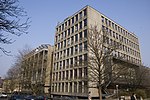The Lido, Bristol
Clifton, BristolCommercial buildings completed in 1850Grade II* listed buildings in BristolLidosSwimming venues in England ... and 1 more
Use British English from February 2023

The Lido, Bristol (grid reference ST576735) is an historic lido situated in Oakfield Place in the Whiteladies Road area of Clifton, Bristol, England. Originally opened in approximately 1850, the pool eventually fell into disrepair and was closed in 1990. Despite being considered for demolition, the building was given Grade II* listed building status in 1998. It was purchased by the Bristol Glass Boat Company who restored the pool, for its reopening in November 2008.
Excerpt from the Wikipedia article The Lido, Bristol (License: CC BY-SA 3.0, Authors, Images).The Lido, Bristol
Saint Pauls Road, Bristol Clifton Village
Geographical coordinates (GPS) Address Nearby Places Show on map
Geographical coordinates (GPS)
| Latitude | Longitude |
|---|---|
| N 51.45889 ° | E -2.61168 ° |
Address
Saint Pauls Road 48
BS8 1RY Bristol, Clifton Village
England, United Kingdom
Open on Google Maps








